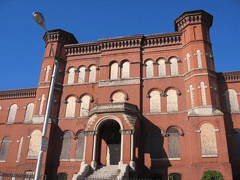Jewish American Historical Places: Hebrew Orphan Asylum
Baltimore, Maryland
The Hebrew Orphan Asylum, built in 1875, is a four-story brick Romanesque structure, the primary façade is on Rayner Street. The corners of the wings and the corner of the central block feature octagonal turrets extending above the roof line. The primary south façade is symmetrical in composition and characterized by a large central porch that provides access to the first floor of the building. The Hebrew Orphan Asylum is substantially attached to the 1944 three-story Colonial Revival building known as the Tuerk House. The area to the north of these structures within the boundaries of the block and the large block immediately to the west of these buildings was formerly the site of several additional structures associated with the Hebrew Orphan Asylum, the West Baltimore General Hospital, and the Lutheran Hospital of Maryland. These associated structures were demolished in early 2009 and these spaces currently remain vacant green space.
 |
On February 1872, the Hebrew Benevolent Society of Baltimore organized a meeting with many prominent citizens at Raine’s Hall to establish an orphanage for the Jewish community. The building was dedicated on May 18, 1873 at 2:00 PM, with speeches, a prayer led by Rev. Dr. Szold from the Hanover Street Synagogue, and the united choirs of all the synagogues in the city singing a hymn. The Hebrew Orphan Asylum opened with eight boys and five girls supervised by Reverend A. Hoffman, formerly a pastor at the Lloyd street synagogue.
The establishment of the Hebrew Orphan asylum fit into a broader pattern of Jewish social service and philanthropy in Baltimore, including the establishment of the Hebrew Education Society (1852), the Hebrew Hospital and Asylum (1866), the Hebrew Free Burial Society (1867), Daughters in Israel (1890), the Milk and Ice Fund (1869), and the Hebrew Immigrant Aid Society (1903). Such efforts required broad and diverse engagement from members of the Jewish community. The Hebrew Orphan Asylum did not have an endowment so its operation depended on donations, including volunteered time, from many people within the Baltimore Jewish community.
Many other Jewish orphanages were built across the United States in the latter half of the 19th century; regrettably few still stand today. Unlike some of its contemporary institutions, the Hebrew Orphan Asylum was not forced to build a new structure because of limited facilities, but rather due to a fire that destroyed the former Calverton mansion. The fire broke out at 9:00 AM on November 12, 1874 originating with a pile of kindling stored in the kitchen. The directors of the Hebrew orphan asylum held a meeting that same evening and passed a resolution to rebuild the asylum.
The Hebrew Orphan asylum was designed by Lupus & Roby, the partnership of Edward Lupus (1834-1877) and Henry Albert Roby (1844-1905), and constructed by Edward Brady (1830-1900). The new Hebrew Orphan Asylum building was dedicated on October 22, 1876. William Rayner again spoke. The Hebrew Orphan asylum was not a “kosher” Jewish institution for Orthodox Russian Jews as it provided a reform education and was operated by German Jews. Children were divided into age groups, with special status assigned to the oldest students. The institution fostered a spirit of competition and placed special emphasis on excellence. Boys and girls had special playrooms, although they did have opportunities to socialize on the playground, doing chores, in the dining room, in the public school, in the Hebrew school, and in the library. Many children had siblings at the institution and family groups often maintained close relationships. During the late 19th and early 20th century, many parents and relatives voluntarily committed their children to orphanages. In a few cases, children came to an orphanage without parental consent following a court order. When parents became able to provide fully for a child, the Hebrew Orphan Asylum confirmed the change and returned children to their custody.
In the early 20th century, reformers began to advocate housing dependent children in a “cottage” system. Physically detached cottages were thought to encourage individualism, intimacy, and close relations between resident adults and children. In 1921, the Jewish Children’s Bureau arranged to merge with the Hebrew Orphan Asylum and the Betsy Levy Memorial Home to form the Jewish Children’s Society, a founding member of the new Associated Jewish Charities. In 1923, the institution moved to Levindale, a new combined institution located near Mt. Washington. By this time, however, ideas around caring for dependent children had changed again and institutional care was considered inappropriate. Levindale closed within a few years and the Jewish community turned to foster care to support dependent children.
The building transitioned to serve as the West Baltimore General Hospital from 1923 through 1945 and finally the Lutheran Hospital of Maryland from 1945 to 1989.
Sources: National Park Service; Extracted from the National Register documentation prepared by Eli Pousson, Field Officer, Baltimore Heritage, Inc.; Photo: This file is licensed under the Creative Commons Attribution-Share Alike 2.0 Generic license. Author: Eli Pousson


